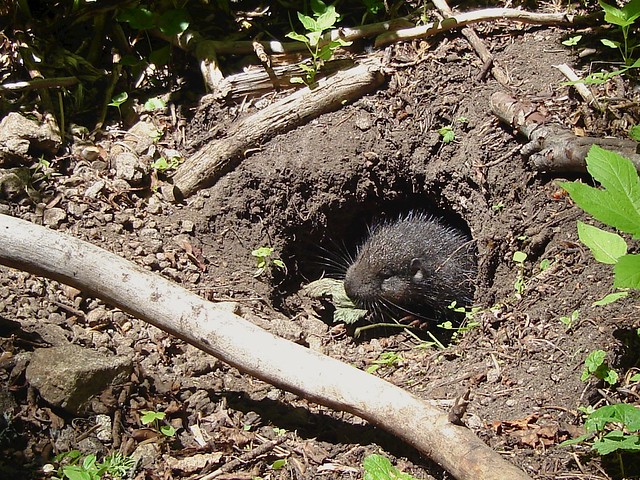Or, in this case, more of a kid boomer.
So, below are 12 cam trap photos from another aplodontia burrow along the Yuba River.
An adult made the first appearance at 4:22pm:



But a couple of days later, at 7:43am, a much smaller aplo shyly peeked out:



Aplodontias only mate once per year, and females typically synchronize locally and have 2-3 altricial young just before spring (i.e., pinkies!), timed to roughly coincide with the seasonally sprouting fresh, nutritious buds and leaves.
Young aplos wean in 6 weeks, emerge from Mom's burrow to forage after about 2-1/2 months, and reach 70% of their adult size and weight at ~ 4 months old.
At a year they're full adults: 2 pounds and as big as a football.
And given those metrics, and the size ratio of the adult and juvenile in all these equally-cropped photos, I'd say this baby boomer is getting near that 4 month mark.
Junior also popped up in full sun at 2:24pm the next day to munch a leaf and look around.




And the adult - likely Mom since aplodontias generally live solo - showed her face one last time the next morning at 6:30am to block up the hole.


Bye, bye until next year, boomers. Watch out for those weasels.
====
References:
- Nature of a Man (this blog) - The Alder Host
- Nature of a Man (this blog) - Boomer the Bulldozer
- Nature of a Man (this blog) - From A to Zapus
- E. W. Jameson Jr. and Hans J. Peeters - Mammals of California
- Mark Elbroch & Kurt Rinehart - Behavior of North American Mammals
- Camera Trap Codger - Camera Trapping Workshop
- Camera Trap Codger - Errant Mountain Beaver
- Wikipedia - Mountain beaver
- Wikipedia - Keystone species

Those are really great photos -- being an easterner I've never seen a mountain beaver.
ReplyDeleteI love their thick noses :) but those ears intrigue me. Most of our subterranean species have lost their external ears (or at least adapted it in some way), but the ears on these guys are so prominent and unique. Do they spend less time underground, do they mostly forage above ground, etc.?
ReplyDeleteYes, they do have interesting human-shaped ears, don't they? They do forage above ground, but bring most of the veg back to their burrows to store and eat later. If I had to speculate on why the outer ears aren't more reduced, I'd guess it's because the Aplodontia is a relic species that hasn't changed much in near 40 million years.
Delete